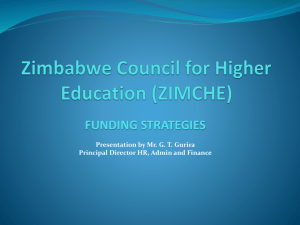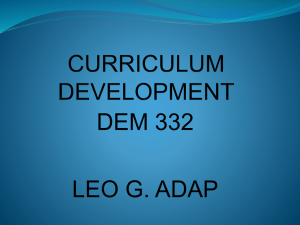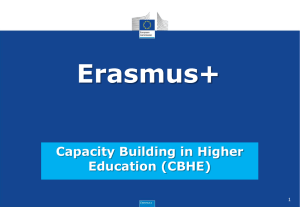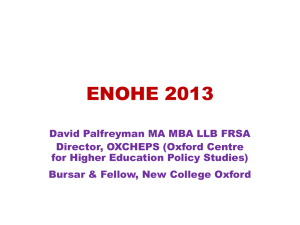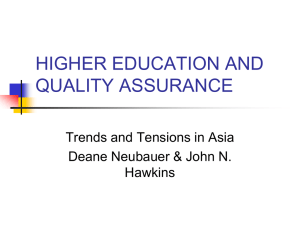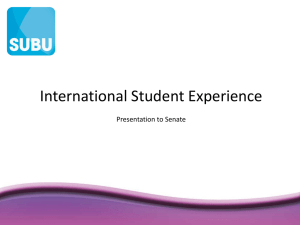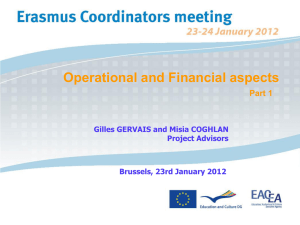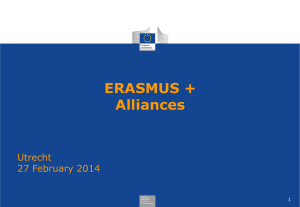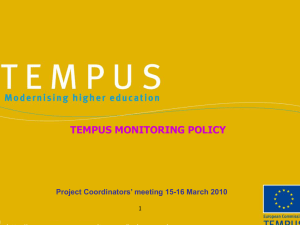Part I - Erasmus+
advertisement
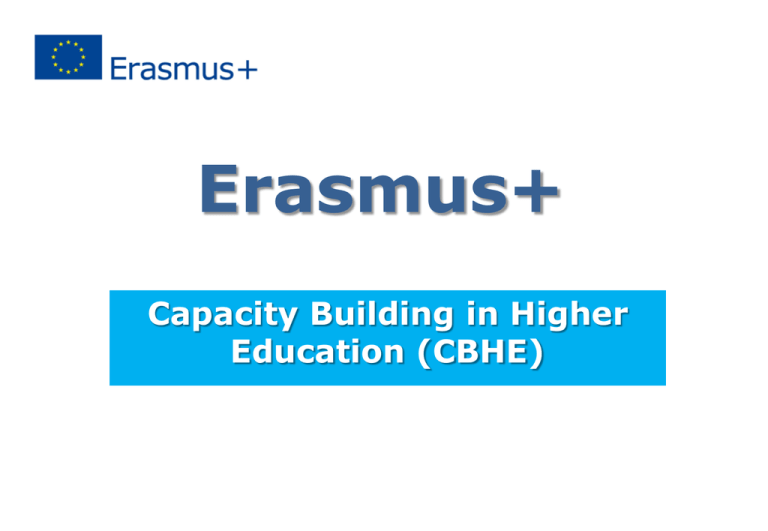
Erasmus+ Capacity Building in Higher Education (CBHE) 1 PART I General Overview of the programme BHE => Capacity-Building Projects are transnational cooperation projects based on multilateral partnerships primarily between higher education institutions (HEIs) from Programme and eligible Partner Countries Part I: Programme/Partner Countries Partner Countries Neighbouring the EU Russia [as recognised by international law] SouthMediterranean countries Western Balkans Eastern Partnership countries Other Partner Countries South Africa Iran, Iraq, Yemen Latin America ACP Call 2016 Asia Central Asia Part I: What for? - Objectives Improve the modernisation and quality of HE and relevance for the labour market and society Improve the competences and skills in HEIs via innovative education programmes Increased capacities of national authorities to modernise their higher education systems Enhance the management, governance and innovation capacities, as well as the internationalisation of HEIs Foster regional integration+ cooperation between different regions of the world Part I: How? – Types of Projects Joint Projects: => Impact Institutions curriculum development university governance & management Links between HE institutions and the wider economic and social environment Structural Projects: => Impact Systems modernisation of policies, governance and management of higher education systems Links between HE systems and the wider economic and social environment Part I: How? Special Mobility Strand Western Balkans, South-Mediterranean and Eastern Partnership countries ONLY Complementary for Joint and Structural projects Additional to the core budget For whom? Students registered in HEIs involved in project consortia Staff employed in a HEI or enterprise in project consortia Programme Country to Programme Country flows are ineligible Part I: Who can Participate? - Eligible Applicants State-recognised public or private Higher Education Institutions Associations/ Organizations of Higher Education Institutions Only for Structural Projects: recognized national or international rector, teacher or student organisations. Each applicant organisation must be located in a Programme or in a Partner country Part I: Who can Participate ? - Eligible Partners State-recognised public or private HEIs Any public or private organisation active in the labour market or in the fields of education, training and youth (e.g. enterprise, NGO etc.) Associations or organisations of HEIs with main focus on HE International governmental organisation (self-financing basis) Each participating organisation must be located in a Programme or in an eligible Partner country – Structure ? Part I: Who can participate? - Associated Partners Eligible Partners? •Contribute indirectly •“Associated partners” are not considered as part of the consortium and therefore cannot benefit from any financial support from the project •Ex: non-academic partners providing placement opportunities Part II – Consortia and financing rules Part II: Consortia Structure Main Principles PROGRAMME COUNTRIES Min. 3 countries min. 1 HEI each Attention to rules on Latin America, Russia PARTNER COUNTRIES Min. 1 country min. 2 HEIs /each STRUCTURAL PROJECTS: Partner Country Ministries for HE must participate At least as many Partner Country HEIs as Programme Country HEIs Ex.1a : minimum consortia: national project (6 HE institutions) Min. 1 Partner Country: at least as many HEIs as in the Programme Countries Military Technical College Min. 3 Programme Countries min. 1 HEI each Bonn University Rome University University Cairo London University UK University Alexandria 13 Ex.2: minimum consortia: multi-country project (7 institutions) Min. 2 Partner Countries Min. 2 HEIs each Belgrade University Novi Sad University Durazzo University Tirana University Min. 3 Programme Countries: Min. 1 HEI each Paris University London University Ankara University Tu rk ey Part II: Priorities & Types of projects National Priorities defined by the Ministries of Education in close consultation with the EU Delegations Regional priorities defined by the Commission and based on EU's external policy priorities National Projects National projects must address: National Priorities set for Partner Country in Regions 1, 2, 3, 7, 10 Regional Priorities for the regions where no national priorities are established: Regions 4, 6, 8, 9 Multi-Country Projects Regional priorities apply to multi-country projects in the same region Combination of regional + national priorities common to all partner countries may also be accepted (in particular for cross-regional projects) 15 Part II: Budget and Duration-Overview Duration 24 or 36 Months Min. 500,000 Euros Max. Excluding 1,000,000 mobility Euros strand Real Costs and Unit Costs 5 Budget Headings Part II: How to calculate the budget -Methods 2 Allocation / Justification 5 Budget Categories Staff Travel – Methods UC UC Cost of Stay – UC Equipment – RC Sub-contracting – RC Real Costs Unit Costs (RC) (UC) Other types of costs (ex.: dissemination, publishing, overheads costs, etc.) are not considered for the calculation of the grant. >>> Expected to be covered by co-funding. Part II: How to calculate the budget –Unit Costs Real costs: How did you use the grant ? => input based =>Expenses incurred, supporting documents Unit costs: what did you achieve with the grant ? =>output based =>No need to prove the actual expenditure but you need to show the "triggering event" (i.e.: the fact the activity was indeed properly implemented (e.g. teaching, training) Part II: Partnership Agreement • Mandatory • To be submitted to the Agency within 6 months of the signature of grant contract (Signed by the legal rep.) • Joint (one doc signed by all partners) or Bilateral (partner A + coordinating inst.) • Template available to be adapted to specific needs of partnership • Comprehensive : covering all aspects of the project: – – – – – – The partners role and responsibilities; Financial Management; Project Management; Project Quality Assurance; Student issues Decision/Conflict resolution mechanisms Part III – The application and Selection procedure Part III- Application and Selection procedure Indicative roadmap for selection process-CBHE Steps Date Publication of the Call for Proposals Oct. 2014 Deadline for submission of applications 10 February 2015 Expert assessment March-April 2015 Consultation of local/regional stakeholders May-June 2015 Award Decision July 2015 Notification of applicants and Publication of results on EACEA web site July-August 2015 Preparation and signature of grant agreements August –September 2015 Start of Eligibility Period 15 October 2015 Part III: How and what do I submit? - General When? How? Where? One deadline - One-phase submission - on-line to EACEA Application form = unique reference information for the submission deadline. What? Specific application form: eForm: project data – parts A, B, C + compulsory annexes: Pre-filled with info from Participant Portal - PIC Detailed project description (Word doc) – parts D, E, F, G, H, I, J Budget tables (Excel doc) Declaration of Honour+ Mandates (in one single PDF doc) Part III: What is assessed? Assessment of CBHE Projects Eligibility Criteria Exclusion & Selection Criteria Award Criteria Part III: What is assessed? Eligibility Criteria Formal submission requirements Grant size and duration Applicant, Partners and Partnership requirements (number of partners, status of the grant applicant & partners, etc.) Part III: What is assessed? Exclusion and Selection Criteria The institution is not in one of the situations described in section C. Exclusion criteria of the Guidelines (such as bankruptcy, professional misconduct, subject of fraud, corruption, administrative penalties, conflict of interest, etc.) Legal person status of the applicant organisation Financial capacity to complete the proposed activities (private entities only) Operational capacity to complete the proposed activities Based on supporting and administrative documents, like the declaration of honour, legal entity form, profit and loss accounts... Part III: What is assessed? Award Criteria Relevance (30 points) Quality of Quality of Design + Implementation Team + Cooperation arrangements (30 points) Impact and Sustainability (20 points) (20 points) SMS Additional Award Criterion To be considered for funding, proposals must score at least 60 points in total and - out of these points at least 15 points for "Relevance" Part III: Budget per region Budget Region Allocation 1 Western Balkans 2015 2 Eastern Partnership countries (in Million €) 3 South-Mediterranean countries Bilateral allocation for Jordan 4 Russia 6 Asia 7 Central Asia 8 Latin America Indicative budget Million € 12,67 13,66 28,06 5 6,72 33,46 8,68 12,26 9 Iran, Iraq, Yemen 1,85 10 South Africa 3,42 TOTAL 125,78 Support Centrally managed (EACEA) but local support : EACEA-EPLUS-CBHE@ec.europa.eu International E+ Contact Points (ICPs) in Programme Countries https://eacea.ec.europa.eu/erasmus-plus/contacts/international-erasmus-plus-contactpoints_en National Erasmus+ Offices (NEOs) in certain Partner Countries (PCs) https://eacea.ec.europa.eu/erasmus-plus/contacts/national-erasmus-plus-offices_en Other useful links: Erasmus+ website - EACEA http://eacea.ec.europa.eu/erasmus-plus/funding/key-action-2-capacity-building-in-fieldhigher-education-2015_en Programme Guide Version 3 (2015): 14/11/2014 http://ec.europa.eu/programmes/erasmus-plus/documents/erasmus-plus-programme-guide_en.pdf Relevant pages in the Programme Guide: PP 145-165; PP 287-295; Part C Erasmus+ website – EU Commission http://ec.europa.eu/programmes/erasmus-plus/index_en.htm Ďakujem za pozornosť! Mgr. Katarína Šmálová erasmusplus@saaic.sk SAAIC – Národná agentúra programu Erasmus+ pre vzdelávanie a odbornú prípravu Bratislava, 13.1.2015 29
